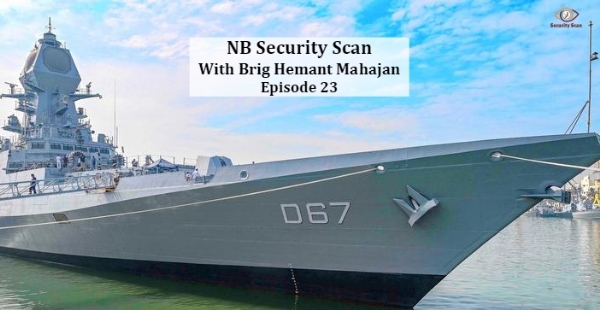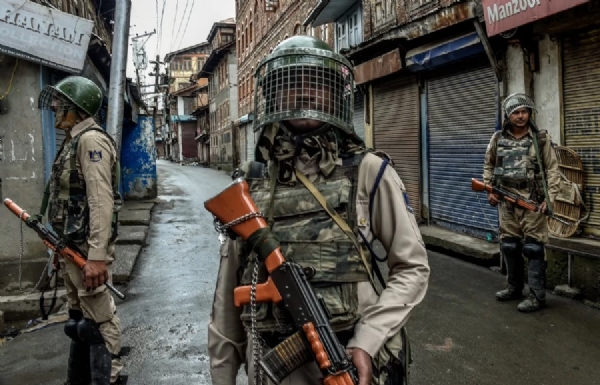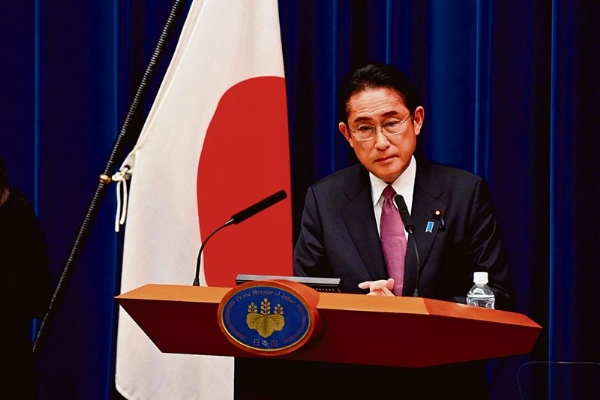#SecurityScan 23: Decline of Terror in Kashmir, INS Mormugao and more
To counter the threat, an enhanced synergy between security and intelligence agencies as well as a engagement with the Army and the BSF should be ensured.
Total Views |
This article is a summary of important events that have taken place in last one week affecting, India's national security.

NEWS IN BRIEF
India must enhance strength by partnering with nations-IAF chief
"Our neighbour continues to remain volatile and uncertain. Amidst this volatility, we must enhance our collective strengths by partnering with nations which share common beliefs and values," Air Chief Marshal VR Chaudhari said.
French defence firm CEO calls on CDS Anil Chauhan
The two discussed the ongoing defence collaboration between the two countries and explored further opportunities under India's 'Atmanirbhar Bharat' initiative. The Naval Group is a major French industrial group specialising in naval defence design, development and construction with its headquarters in Paris.
CAG- delays in implementation of measures to strengthen security of coastal and offshore naval assets
"The urgency in CCS's sanction (February 2009) following the 26/11 terror attack for setting up a maritime force (Sagar Prahari Bal, SPB)) within a period of three years so as to provide security to all coastal and offshore naval assets, was diluted due to delays in creating the enabling setup (Fast Interception Crafts, FICs, and manpower infrastructure)," the CAG said in a press statement.
Indian Navy gets 5th Scorpene-class submarine Vagir
India has been focusing on shoring up its maritime capability with a focus on the Indian Ocean in the backdrop of concerns over China's growing forays into the region. Project-75 includes the indigenous construction of six submarines of Scorpene design.
India acquiring 'Pralay' missile for striking targets as far as 500 km
"Pralay' is a quasi-ballistic surface-to-surface missile. The advanced missile has been developed in a way to able to defeat interceptor missiles. It has the ability to change its path after covering a certain range midair.
Pakistan launches major operation to flush TTP militants
The standoff began on Sunday when an arrested TTP militant, who was being interrogated at the Counter-Terrorism Department (CTD) police station inside the Bannu Cantonment, snatched an AK-47 from the police and opened fire.
Def Min to discuss Army proposal for acquiring 354 'Zorawar' tanks
The Indian Army has issued specifications for its future light tank which has been named 'Zorawar'. The tank has been named after the legendary general who led multiple successful victories in Tibet which is now controlled by the Chinese Army. The tank has been named after the legendary general who led multiple successful victories in Tibet which is now controlled by the Chinese Army.
Capital procurements worth Rs 2.46L crore for forces approved in last 3 yrs
"The government, in the last three years that is from 2019-20 to 2021-22 and current year (2022-23 up to September 2022), has accorded Acceptance of Necessity (AoN) to 163 proposals worth Rs 2,46,989.38 crore approximately, under various categories of capital procurement which promote domestic manufacturing as per DAP-2020.
India, China dialogue: fresh talks on eastern Ladakh row
"They had a frank and in-depth discussion, keeping in line with the guidance provided by the state leaders to work for the resolution of the remaining issues at the earliest which would help in restoration of peace and tranquillity along the LAC in the Western sector and enable progress in bilateral relations.
Defence chiefs of US and India discuss issue of global security
Seeking to deepen US-India military ties, the defence chiefs of the two countries have shared their assessments of the regional and global security environment and discussed ways to deepen bilateral cooperation and interoperability.
The call between US Joint Chiefs of Staff Gen Mark A Miley and his Indian counterpart Chief of the Indian Defence Force Gen Anil Chauhan took place amidst increased tension between India and China on the border.
In 2017, the US, Australia, India and Japan gave shape to the long-pending proposal of setting up the Quad to develop a new strategy to keep the critical sea routes in the Indo-Pacific region free of any influence.
Possibility of enlarging UNSC on table- UN chief Antonio Guterres
The UN chief added that reform of the Security Council needs two-thirds of the votes of the General Assembly plus the five positive votes of the permanent members of the Security Council - China, France, Russia, UK and the US.
Technological Security-High Stakes In Low Orbit
The competition to provide broadband from low Earth orbit (LEO) is one of the most important, least appreciated geostrategic developments underway. India should consider the economic and strategic implications of LEO satellite constellations, which promise to dramatically improve coverage in underserved markets and bring more of the world online. In addition to reaping vast commercial rewards, nations with leading LEO broadband providers could enjoy increased resiliency in their communications, accuracy in positioning services, and even enhanced early warning capabilities.
An elite group of companies, primarily from the United States and Europe, are on the cutting edge of these efforts. China has its own plans for LEO broadband, deep pockets of state funding to pursue those ambitions, and political ties to leverage through its Belt and Road Initiative. As the LEO broadband competition intensifies, India need an accessible guide to these developments and recommendations for advancing Indian interests.
INTERNAL SECURITY
Decline of Terror in Kashmir
The decline in terror incidents in Kashmir is significant. An atmosphere of relative calm has kindled hope. After decades of violence, a new generation is getting a feel of normalcy. The Centre says 123 terror incidents were reported in the UT until November 30 this year, down from 229 in 2021. It’s a marked drop that signifies that the security grid has gained a firm control. Sustained and focused anti-terror operations are showing results.

Pakistan has opened a new frontier with its drone-driven activities, engaging border forces 24x7. Desperate attempts are also being made to bring the neighbouring Punjab within the ambit of its narco-terror designs.
Engaging hybrid terrorists and small-time criminals is the latest strategy being adopted. To counter the threat, an enhanced synergy between security and intelligence agencies as well as a engagement with the Army and the BSF should be ensured. A decisive change has been brought about through the crackdown on terror funding. The frequent raids on the collaborators, based on specific information, amply demonstrate the zero-tolerance strategy. Centre claims it has achieved a 94 per cent conviction rate in such cases.With the delimitation process completed, the announcement of Assembly elections in Jammu and Kashmir is awaited. Empowering the citizen is vital.
Self-Reliance Programme In Indian Navy
The commissioning of INS Mormugao is a reassuring step forward in the self-reliance programme, providing a boost to the country’s maritime capability. Nearly 40 ships and submarines are being built in Indian shipyards.INS Mormugao undertook her first sea sortie on December 19. Designed by the in-house Warship Design Bureau and constructed by Mazagon Dock Shipbuilders, over 75 per cent of its components are indigenous. Second of the four Visakhapatnam-class warships, the stealth-guided missile destroyer is packed with sensors, radar and weapon systems.
Next-generation locally-designed-and-built vessels hold the key to success in any future war. While there are signs of a maturing military-industrial complex in India, the slow turnaround by the naval shipyards is a matter of concern. Despite considerable efforts, warship construction endeavours continue to suffer from systemic deficits. A programme mired in delays and cost overruns needs a critical audit. The project to construct six next-generation conventional submarines has now been further delayed.
Shipbuilding has to be treated as a strategic enterprise, with budget requirements being taken care of on priority. To achieve greater participation from the private sector, the Navy has made available its facilities for testing, trials and tuning of equipment during the development stage. The Naval Innovation and Indigenisation Organisation provides an interface for the academia and industry to interact with the Navy’s capability development apparatus. Efforts are afoot to address the problem areas, but the challenges are formidable.
Harsimrat Badal on Punjab CM Bhagwant Mann in Lok Sabha on drug abuse
Shiromani Akali Dal lawmaker Harsimrat Kaur Badal on Tuesday targeted Punjab chief minister Bhagwant Mann during a debate in the Lok Sabha on the issue of drug abuse.
“Alcohol is nothing but an addiction. And I am trying to say how addiction is affecting people,” said former Union minister Badal, who initiated the debate on the problem of drug abuse and the steps taken by the government. “If the chief minister is like this then you can imagine what the condition of the state will be.”
She also said that “the lawmakers who used to sit next to Mann wanted to change their seats.The Punjab chief minister had to be deboarded from a Lufthansa flight a few months ago. Stating that the law-and-order situation in Punjab was deteriorating, Badal claimed that “drugs had even entered schools”. “No one feels safe here. People are leaving the state (Punjab) and going abroad because of the drug menace.
Several Lok Sabha members on Tuesday said that political parties should put aside their differences and come together to fight drug abuse, while asking the government to take “urgent” steps to save the youth.
When leader of Akali Dal in Lok Sabha makes a statement, it is to be taken very seriously. What Mrs Badal said is well-known. Drunk person is not allowed to drive a vehicle but as Mrs said drunk person now is running the state, which is very dangerous as drugs and liquor has reached every home and ruining the youth of Punjab.
EXTERNAL SECURITY - COUNTERING CHINESE MULTI DOMAIN WAR
'CCP Inc.' in Malaysia a benefit or a liability
Is China’s state capitalist system a benefit or a liability for Chinese companies? The case study focuses on two of China’s most prominent tech companies, Huawei and Alibaba, for insight into how the “CCP Inc.” ecosystem of Chinese party-state actors can both support and constrain private sector firms. In Malaysia, both companies rapidly expanded their footprints throughout the 2010s, becoming deeply integrated in national telecommunications, artificial intelligence, and e-commerce infrastructure—and opening doors for other Chinese companies in Malaysia’s tech sector along the way.

In the past few years, however, Huawei and Alibaba have both faced major hurdles due to their integration in the CCP Inc. state capitalist system. Political pushback against Huawei is damaging its ability to expand internationally, while a government crackdown on China’s own tech sector is challenging Alibaba’s growth prospects.
China developing mines in Tibet
In recent years, China has been developing the Huayu gold mine in Lunze (Lhuntse) in south Tibet, near the border of Arunachal Pradesh, a part of India that China claims. The mine may hold as much as $60 billion in gold, silver, and other minerals, including rare earths, according to Chinese geologists. Development accelerated in 2017, the same year India and China had a tense 73-day stand-off in Doklam on the western border of Bhutan, over Indian opposition to China's building a road on territory claimed by Bhutan, a position that India supports.
In an unusual personal reply to a letter from a herding family in Lhunze on October 28, 2017, Xi Jinping "encouraged them to set down roots in the border area, safeguard the Chinese territory and develop their hometown.
Aksai Chin is home to the Huoshaoyun lead-zinc mine, Asia's largest metals deposit and the world's seventh largest, with recoverable reserves of 18.87 million tons of high-grade zinc and lead. This mine will nearly double China's current supply of mined zinc, currently 44.39 million tons.
As the standoff with Indian troops was underway in Eastern Ladakh since early May, China constructed a new permanent road along the Line of Actual Control (LAC) that gives it access to a mountain area believed to be rich in natural deposits.
The blacktopped road, designed to take on heavy transport vehicles, has come up right next to the LAC close to India’s Gogra post, in an area that satellite images suggest hold valuable natural resources like gold.
Japan sheds constraints on its military to develop counter strike capability
Japan has laid the foundation for a new set of defence and security policies for the years to come and in the process, it has taken a giant step to shed the self-imposed post-World War II constraints on its military.
Last week, Prime Minister Fumio Kishida’s government revised three key documents after months of debate, putting out a tough new approach to the region, where it has to confront the North Korean missile threat, China’s increased muscle-flexing, and the fallout of the Ukraine war. The developments in Europe have acted as a catalyst of sorts in pushing the Japanese decision-making. “Ukraine today may be East Asia tomorrow.
The new National Security Strategy (NSS) says that Japan “is facing the most severe and complex security environment since the end of World War II.” And in an oblique reference to China and Taiwan, it also noted that there was growing pressure “by those seeking to unilaterally change the status quo by force.”
A major driver of this change is the increasing worry that China could attempt to reunify Taiwan by force in the coming decade. In August this year, in a bid to coerce Taiwan, five Chinese ballistic missiles landed in the Japanese EEZ.

The most dramatic shift is Tokyo’s decision to create a counter-strike capability based on long-range missiles that can take out enemy bases and command and control nodes. Till now, Japan’s posture was wholly defensive, reliant on anti-ballistic missile capability to shoot down missile targeting Japanese facilities.
As part of this new strategy, Japan will enhance the range of its own Type 12 missiles and buy US-made Tomahawk missiles with a range of 1,600 km or so over the next five years. These plans are outlined in the other two documents — the National Defence Strategy (NDS), which lays out the defence policy, and the Defence Program, which provides an outline of the procurement and spending plans.
Another area which will see a dramatic expansion is the Japanese cyber war capability. This will involve adding thousands of more cyber specialists to the Self-Defence Forces (SDF) core, raising the total to about 20,000. The documents also notes that the SDF will create a permanent joint command to oversee its ground, maritime and air components.
The government has made it clear that it is no longer bound by the traditional restriction of keeping its defence spending at one per cent of the GDP. Now, Japanese officials have been asked to obtain a budget equal to two per cent of the GDP by 2027. Kishida has ordered the five-year defence plan to be hiked by 60 per cent to some $315 billion. Not only would this bring Japan in line with the NATO defence spending standard, but also enable Japan to become the third largest defence spender in the world after the US and China. As it is, the Chinese and Japanese have a significant dispute over their maritime boundary in the sea between Japan and Taiwan.
The net loser in all these developments is China. Now, Japan is coordinationing and cooperating with allies and partners to check Beijing. Japan has made it clear that it would not stand by while Taiwan was overwhelmed.
This is a very good news for India, as Chanakya had said enemy's enemy is your friend and when countries like Japan and Southeast Asia improve the defensive potential to counter China it is only to be welcomed.
--


